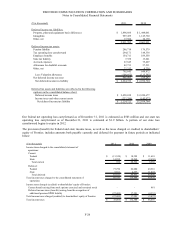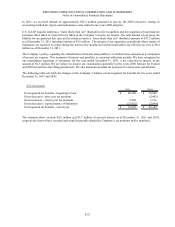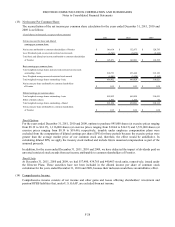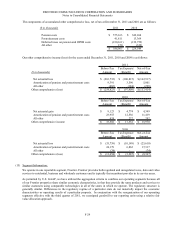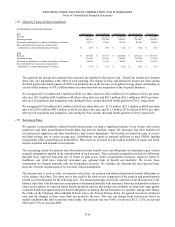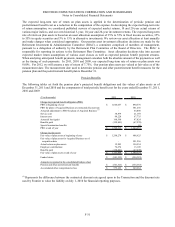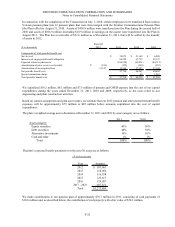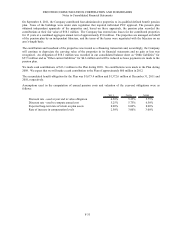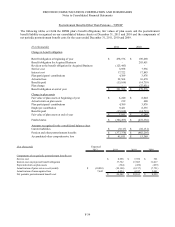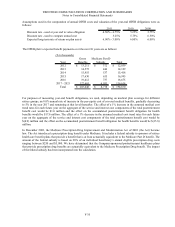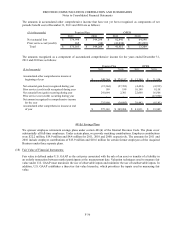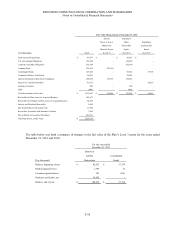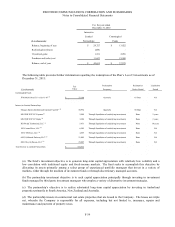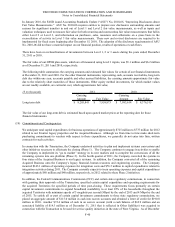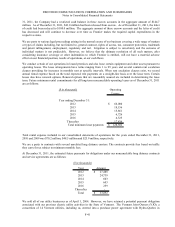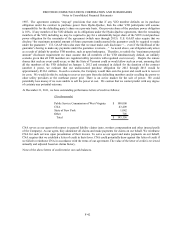Frontier Communications 2011 Annual Report Download - page 98
Download and view the complete annual report
Please find page 98 of the 2011 Frontier Communications annual report below. You can navigate through the pages in the report by either clicking on the pages listed below, or by using the keyword search tool below to find specific information within the annual report.
FRONTIER COMMUNICATIONS CORPORATION AND SUBSIDIARIES
Notes to Consolidated Financial Statements
F-35
Assumptions used in the computation of annual OPEB costs and valuation of the year-end OPEB obligations were as
follows:
2011 2010 2009
Discount rate - used at year end to value obligation 4.50% - 4.75% 5.25% 5.75%
Discount rate - used to compute annual cost 5.25% 5.75% 6.50%
Expected long-term rate of return on plan assets 6.00% - 3.00% 6.00% 6.00%
The OPEB plan’s expected benefit payments over the next 10 years are as follows:
($ in thousands)
Gross Medicare Part D
Year Benefits Subsidy Total
2012 13,211$ 372$ 12,839$
2013 14,575 446 14,129
2014 15,955 537 15,418
2015 17,630 635 16,995
2016 19,412 737 18,675
2017 - 2021 122,665 6,051 116,614
Total 203,448$ 8,778$ 194,670$
For purposes of measuring year-end benefit obligations, we used, depending on medical plan coverage for different
retiree groups, an 8.0% annual rate of increase in the per-capita cost of covered medical benefits, gradually decreasing
to 5% in the year 2017 and remaining at that level thereafter. The effect of a 1% increase in the assumed medical cost
trend rates for each future year on the aggregate of the service and interest cost components of the total postretirement
benefit cost would be $1.0 million and the effect on the accumulated postretirement benefit obligation for health
benefits would be $17.6 million. The effect of a 1% decrease in the assumed medical cost trend rates for each future
year on the aggregate of the service and interest cost components of the total postretirement benefit cost would be
$(0.9) million and the effect on the accumulated postretirement benefit obligation for health benefits would be $(15.8)
million.
In December 2003, the Medicare Prescription Drug Improvement and Modernization Act of 2003 (the Act) became
law. The Act introduced a prescription drug benefit under Medicare. It includes a federal subsidy to sponsors of retiree
health care benefit plans that provide a benefit that is at least actuarially equivalent to the Medicare Part D benefit. The
amount of the federal subsidy is based on 28% of an individual beneficiary’s annual eligible prescription drug costs
ranging between $250 and $5,000. We have determined that the Company-sponsored postretirement healthcare plans
that provide prescription drug benefits are actuarially equivalent to the Medicare Prescription Drug benefit. The impact
of the federal subsidy has been incorporated into the calculation.



